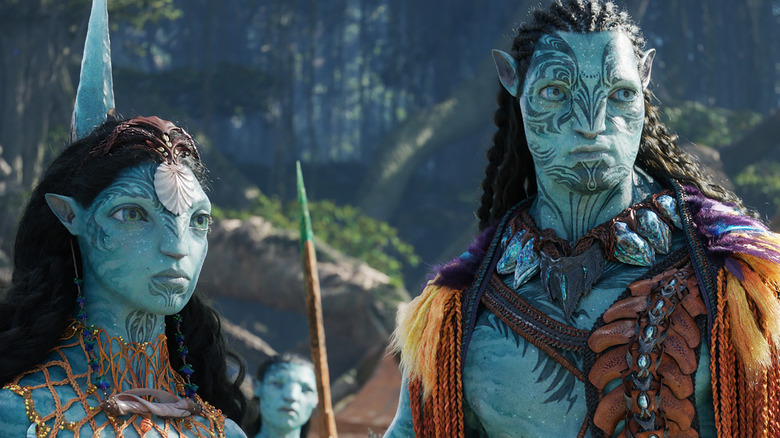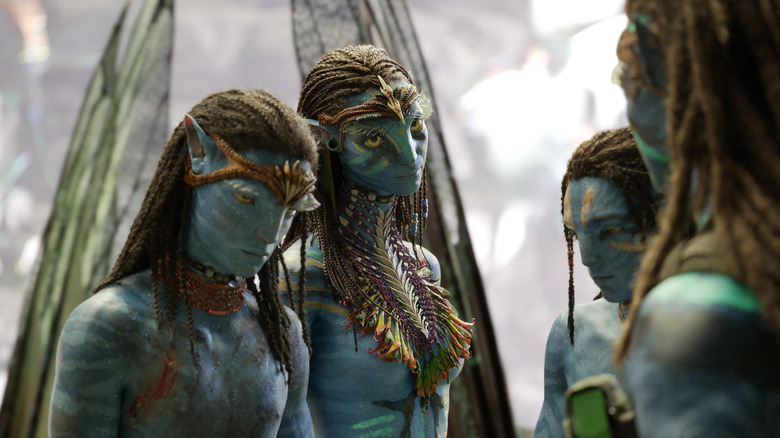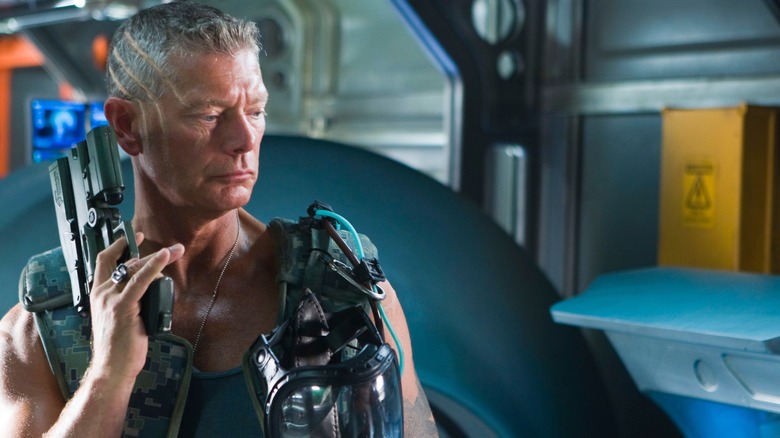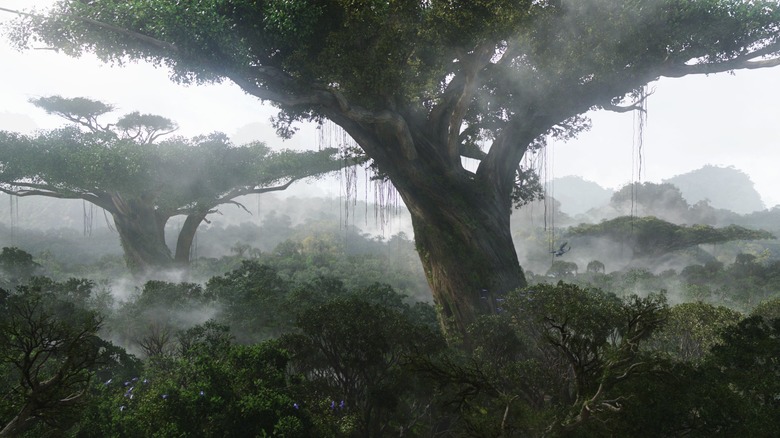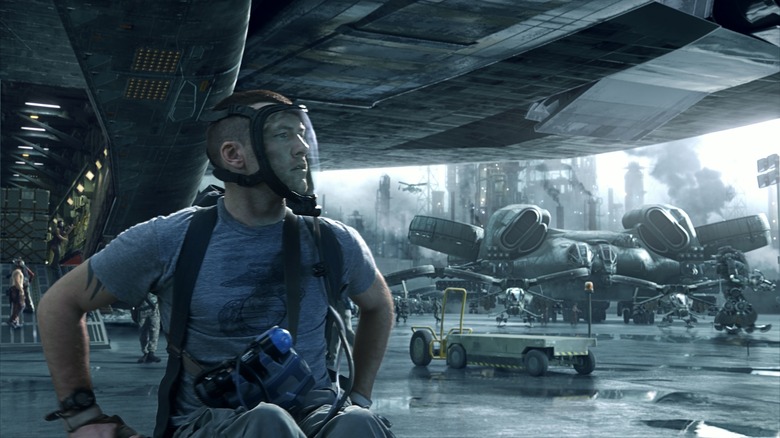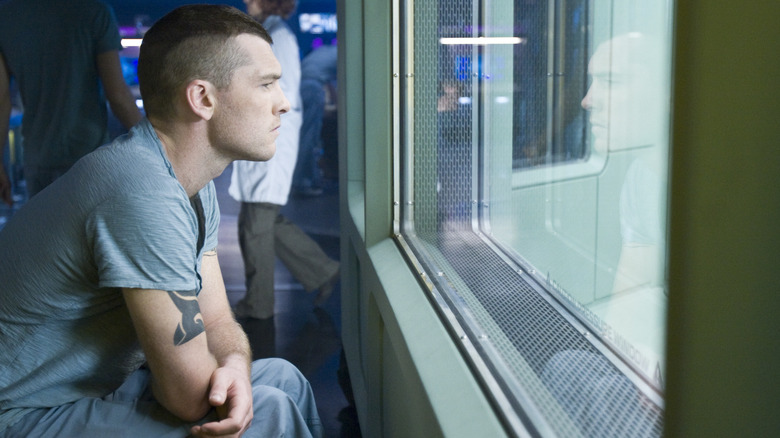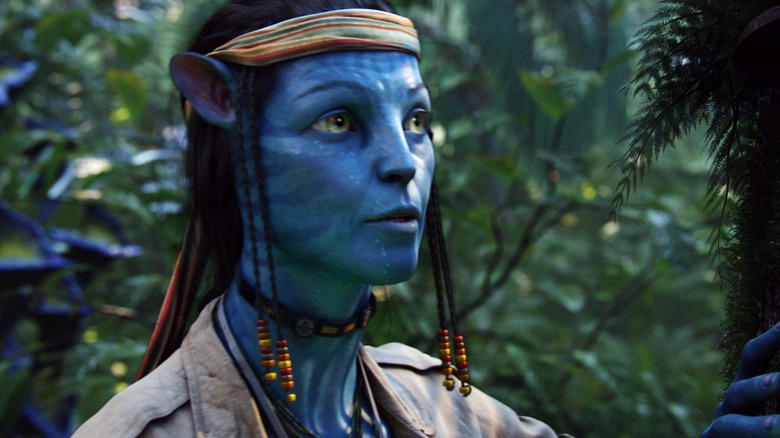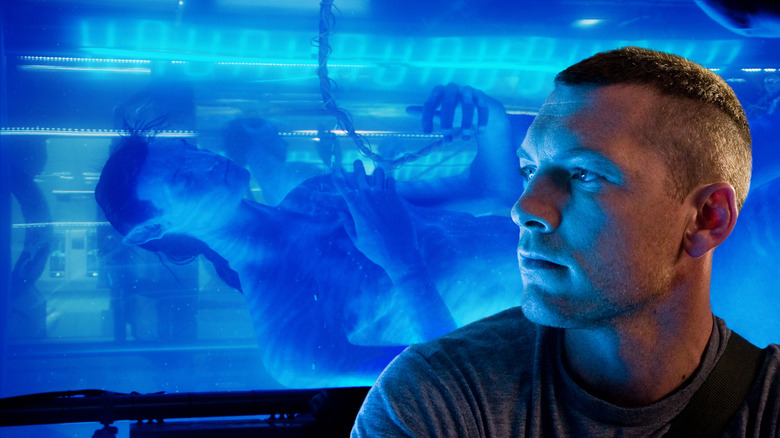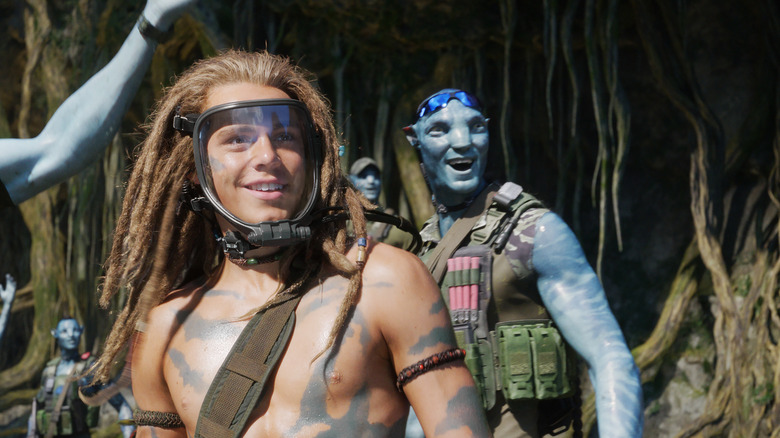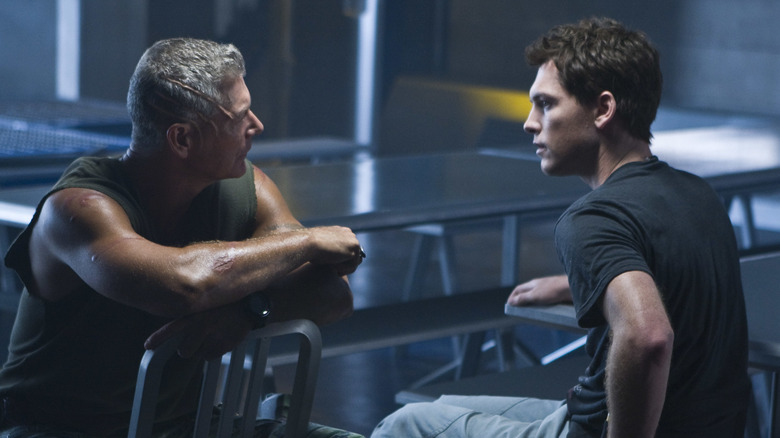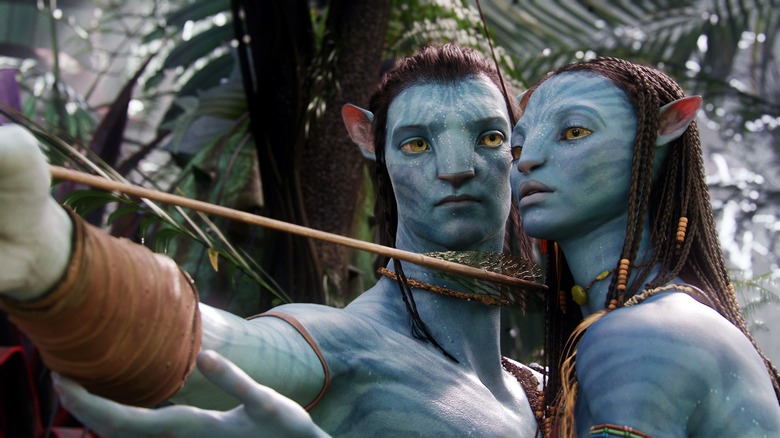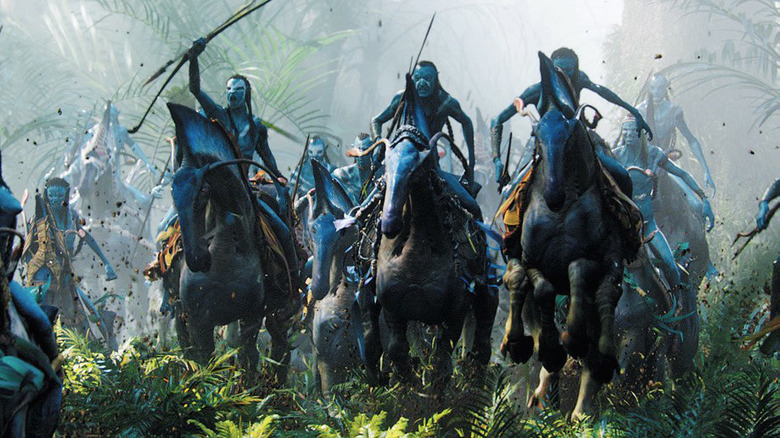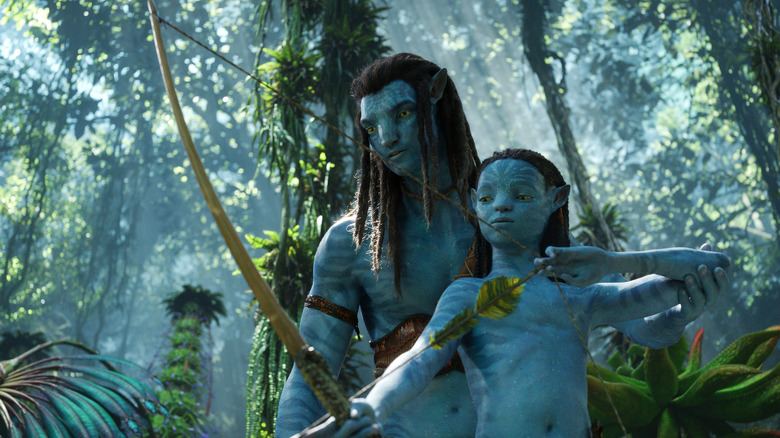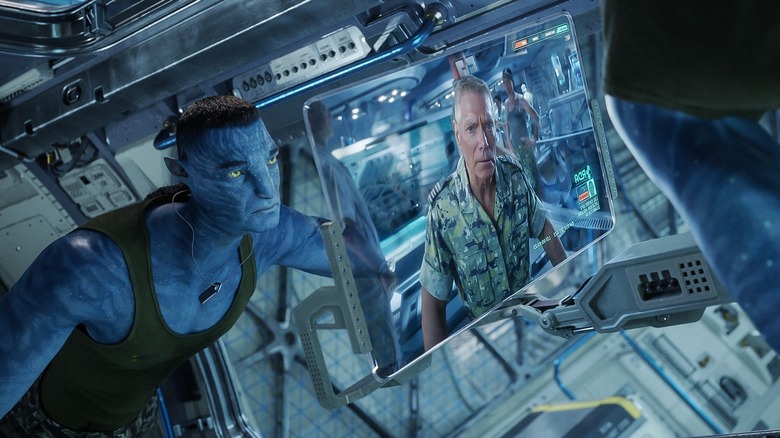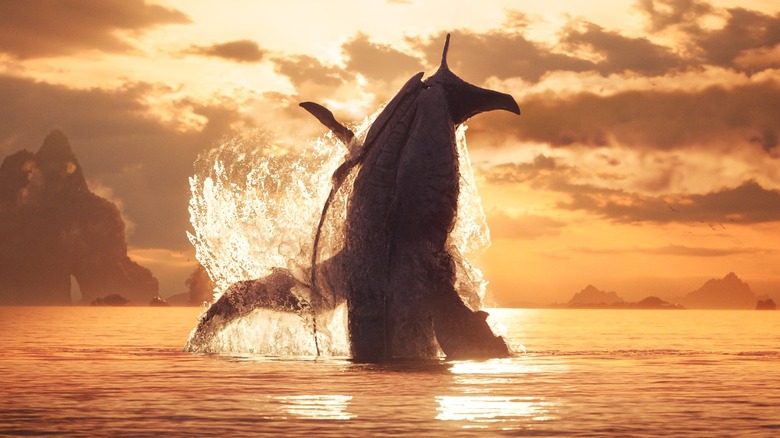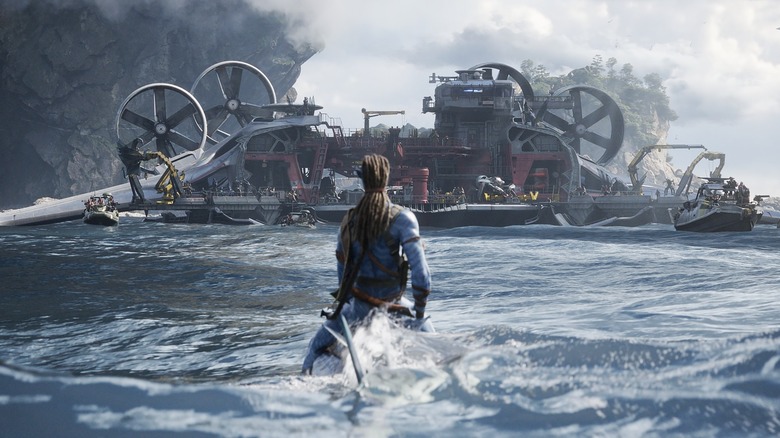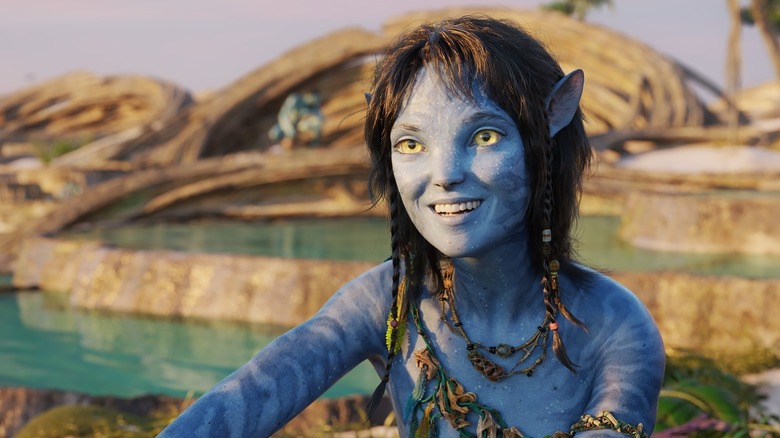The Entire Avatar Timeline Explained So Far
How long does it take to bulldoze a planet and put up a parking lot? Even Joni Mitchell could tell you, it all depends on how much resistance you get from the local population.
In James Cameron's box-office dominating "Avatar" franchise, time has weight. It takes years to travel from Earth to the lush, strange world of Pandora, and whole groups of characters are born and grow up between films. The series also has an extensive backstory only briefly referenced in the movies, but with a huge impact on the action therein. How long does it take to wipe the stink of colonial invaders off your planet? The jury is still out.
The story of "Avatar" began long before Jake Sully (Sam Worthington) ever set foot on Pandora; if Cameron has its way, it won't be finished for many, many years. That long runway could give the director and his writers room time to undo some of the series' more problematic elements — in particular, the questionable-at-best handling of its indigenous narrative. "Avatar: The Way of Water" improves on that front in some ways over the original, but not as much as you'd expect after a 13-year gap. How long will it take for Hollywood blockbusters to stop copy-pasting the same white savior cliches? That's a far more dubious timeline.
The "Avatar" franchise has a complicated, twisty story likely to only get more epic as additional films roll out. After two packed with off-camera lore and worldbuilding, as well as a number of extraneous canonical sources, Cameron's sci-fi universe is more complicated than you might think. This is the entire "Avatar" timeline thus far, explained.
The First Songs
Before launching into the sci-fi timeline of "Avatar," you have to go way, way back to the origins of the Na'vi. Little is known about the species' actual history, but there are numerous references in the films and comics to the "First Songs" — stories from the early days of the clans, which have been passed down as both lessons and communal memories. These tales include the story of the first Toruk Makto, and the beginning of the Na'vi's communion with Eywa.
It's unclear exactly how long the Na'vi have existed in their current state, but the First Songs suggest it's been a very long time. Most of the cultural traditions and hierarchical structures of the clans are largely unchanged from what's reflected in their histories. This implies that Na'vi have existed in harmony with the rest of Pandora for most of their known past, explaining why they haven't felt pressured to change their ways or alter their environment in any major way. Of course, all that changes when the humans begin to arrive.
Emergence of the RDA
The first major human event in the known "Avatar" timeline is the founding of the Resources Development Administration, or RDA for short. If you've only seen the movies, you might know the group simply as a quasi-fascist military-industrial conglomerate bent on demolishing the Na'vi's natural way of life for profit. While all of that is true, the RDA has a long history that precedes its infamy as a force for global conquest.
According to information included in "James Cameron's Avatar: An Activist Survival Guide," the RDA was founded in the early 21st century — likely not far out from our own present moment — in Silicon Valley. The company's fast success led to the creation of its most important asset: the global maglev train network that came to span the globe. Through the RDA's worldwide transit system, people could live and work in two completely different places. A fully-realized and somewhat scary version of real-world globalized industry, the maglev network also helped lead to the colonization efforts on Pandora.
In order for the high-tech transit network to function, the RDA needed a rare superconductor — unobtanium. Anyone who's seen the first "Avatar" will know that the valuable resource is the main focus of the RDA's presence on Pandora, though the group's plans eventually become much larger than simple mining.
Discovery of Pandora and early visits
Pandora was discovered by humans via long-distance telescopes and astronomical equipment on Earth in the late 21st century. The now-defunct promotional tie-in game "Pandora ROVR" followed the first unmanned voyage to the moon, which mostly consisted of short-term drone exploration. These early visits began in 2084, according to the game.
At first, these ventures only observed the natural ecology of Pandora, which itself was surely enough to warrant attention from humanity. The state of Earth at the end of the 21st century was becoming dire, and things only got worse as time went on. Global politics began to get more unstable, independent corporate organizations like the RDA gained more and more power, and the natural environment of Earth continued to be depleted, with major species gradually going extinct.
For all these reasons, interstellar exploration must have been of primary interest for many. However, for the agents (and shareholders) of the RDA, Pandora held a more material interest. The moon's rich deposits of unobtanium and other strange, promising natural qualities presented unprecedented opportunities for exploitation and profit. And so, more manned missions began to be planned in earnest.
Human occupation
Relatively early in the 22nd century, humanity's presence on Pandora really launched into full swing. We know this because the RDA's operations were active for at least a few decades prior to Jake Sully's arrival in 2154. This point in the timeline hasn't been explored in any great canonical detail as of yet, but some things can be inferred from what's said and shown in the movies.
By the time Jake gets to Pandora, things are already in full swing. The RDA and the Pandoran Research Foundation have become a well-oiled machine for mining unobtanium and clearing land, and though there were several recorded confrontations between the humans and the Na'vi early on, the tension between the two species remained mostly just that — tension.
According to information presented in "Avatar: The Game," the Avatar Program itself was initially designed as a means to produce more efficient workers for the RDA's Pandoran mining operations. However, the cost was deemed too high for such purposes, and the technology was reallocated for scientific and diplomatic purposes.
Crisis on Earth
During the early years of the RDA's Pandoran occupation, things on Earth only get worse.
Through the first half of the 22nd century, the planet is devastated by both natural disasters — including a massive tsunami on North America's Pacific coast, according to "Avatar: The Game" — and war. Jake talks a bit throughout the original "Avatar" about his time fighting as a marine. Viewers still don't have a full picture of what the war he fought in looked like, but the bits and pieces revealed in the movies paint a pretty vivid picture.
As climate and ecosystem degradation led to more natural disasters, disease, and fewer available resources, world governments began to wane in power and influence. Independent groups like the RDA — referred to in "James Cameron's Avatar: An Activist Survival Guide" as "quasi-governmental administrative entities," or QGAEs — gradually became the dominant power structures on Earth, but that didn't stop conflicts from breaking out all over the world. It is known from the first film that Jake fought in Venezuela, and that Colonel Miles Quaritch (Stephen Lang) did multiple tours in Nigeria. However, the details of those conflicts are still somewhat vague.
What's clear is that Pandora became increasingly important to humanity as a whole throughout this first part of the 22nd century. Its promise of abundant natural resources and a healthy, safe atmosphere for potential colonization made it incredibly valuable, pushing the RDA to take on whatever measures necessary to claim it as their own.
Grace Augustine's school for the Na'vi
In 2142, Dr. Grace Augustine (Sigoruney Weaver) founded a school for Na'vi children on Pandora with the goal of exchanging information between the two species. It is known that the school was founded in 2142 because she says in "Avatar" that she operated it for a decade, and the school was closed down after a massacre that took place in 2152 — just two years before Jake Sully's arrival.
Grace's path to creating the school isn't exactly simple. Her early proposition for such an institution is received doubtfully by the Omatikaya, but when several Na'vi children — including Neytiri (Zoe Saldaña) and her sister Sylwanin — show interest, they relent. Things become more complicated when RDA pollution of the local water supply leads to a dangerous illness in the Omatikaya, but a combined effort from Grace and Mo'at (CCH Pounder) yields a cure. This storyline is covered in the "Avatar: Adapt or Die" comic. The schoolhouse is built, and Grace begins teaching English and embarking on a larger cultural exchange with the Na'vi.
In 2152, Grace's students become upset at the ever-increasing damage the RDA is doing to their home. Sylwanin leads several of the children on a mission to destroy an RDA bulldozer, resulting in SecOps soldiers arriving and killing her and several others. This vile massacre leads to the immediate closure of the school and causes the Omatikaya to cut off all official diplomacy with the humans, as explored in both the first film and the "Avatar: Tsu'tey's Path" comic.
It's worth noting that the concept of violent English schools for indigenous children is rooted in real, detestable history. "Avatar" attempts to toe a line by making Grace an ally of the Na'vi and giving her excited, voluntary students, but it's heavily debatable how well the franchise actually pulls this off.
Jake Sully is recruited
In 2145, Jake Sully's twin brother Tommy — a brilliant scientist — began training for the Avatar Program. This much is known because Tom was killed in 2148, and Grace tells Jake in the first movie that his brother trained for three years. That's a lot of time spent preparing for Pandora, and it all wound up being for nothing when Tommy was cut down by a mugger shortly before he was supposed to head into space.
This tragedy is what throws Jake into the driver's seat of the story. Because Tommy was his twin, he's able to use the avatar that was made for him, thus ensuring that the massive amounts of money necessary to create a single avatar aren't wasted. The nature of Tommy's death also gives a good indicator of the state of the world at the start of "Avatar." From how Jake talks about it, it is clear that such random acts of violence are far from rare, as the Earth spirals into chaos.
Of course, being recruited for the Avatar Program and actually arriving on Pandora are two different things. Jake, Norm (Joel David Moore), and the rest of the ISV Venture Star crew leave Earth in 2148, but they don't arrive on Pandora until 2154 — six full years later. The magic of cryo-freezing technology makes the time fly by, but a good deal happens in the interim.
Events of James Cameron's Avatar: The Game and canon status
In conjunction with the release of the first "Avatar," several other media tie-ins were produced, including "James Cameron's Avatar: The Game." A third-person action game released on major consoles at the time, the game is one of the biggest "Avatar" spin-off projects to date in terms of original worldbuilding. The story follows Able Ryder, a member of the Avatar Program stationed on Pandora in 2152 — the same year Grace's school was shut down, and two years before Jake Sully's arrival.
From its release, the game was difficult to lock into concrete canon or non-canon status, in large part because the player's choices would yield drastically different endings. However, in a 2023 interview as part of OmatiCon, Lightstorm Entertainment Vice President of Franchise Development Joshua Izzo confirmed that none of the games released in 2009 are currently considered canon. This makes sense, as many of the events depicted in "Avatar: The Game," including major battles between the RDA and the Na'vi and the destruction of important spiritual sites, seem odd not to mention in the first film.
However, "James Cameron's Avatar: The Game" still warrants some mention here. While the game itself has been removed from the canon, there's been no official word on the in-game encyclopedia entries, which to date offer some of the most expansive lore and worldbuilding explanations available in the franchise. Producer Jon Landau has said that future video games will be canon, but set far enough apart from the story of the films that they won't overlap (per Polygon).
Spider is born
One of the biggest questions in "Avatar: The Way of Water" pertains to the origin of Spider (Jack Champion). At least, if you haven't read the comics.
Confirmed to be the biological son of Miles Quaritch in "Avatar 2" (and even bearing his name), Spider is left behind on Pandora when the other humans are sent home by the Na'vi because babies can't be put in cryosleep. As a result, he's raised by Jake and Neytiri as part of their own family, and by the time his reincarnated father returns with the RDA, Spider has come to despise them. That means Spider would have been born just months before Jake's arrival on Pandora. And yet, Quaritch makes no mention of him, or of a romantic partner.
The graphic novel "Avatar: The High Ground," released just shortly before "The Way of Water," details many events that are only briefly alluded to in the film, including the return of the RDA to Pandora and the beginning of the ensuing war with the Omatikaya. At one point in the comic, Spider tells Kiri (Sigourney Weaver) that his mother, a woman named Paz Socorro, also died during the attack on the Tree of Souls at the end of "Avatar." Paz is never mentioned in "The Way of Water," however, and it's unclear exactly what her relationship with Quaritch was like.
Jake arrives on Pandora
It's wild to see just how many major historical events in the "Avatar" timeline occur before Jake Sully ever sets foot on Pandora. Of course, it's his arrival in 2154 that really kicks off the main action of the franchise. At first, Jake doesn't seem like he'll be too important — just a self-described jarhead thrust into the Avatar program in the interest of saving a few (million) bucks. But thanks to the wombo combo of convenient circumstances and white saviorism, he gets to be the protagonist of the whole dang thing.
Jake literally stumbles into his role in the story, disrupting the local wildlife against Grace's advice and getting hopelessly lost in the jungle as a result. His avatar probably would have died there, too, if not for the intervention of Neytiri. She initially plans to kill him as an invader on Omatikaya land — something that makes complete sense given that her own sister was murdered by RDA forces. However, she becomes convinced to let him live after getting what she interprets as a sign from the Tree of Souls.
This "sign" is never fully explained. Jake seems to justify it by taming the toruk, but he does so in such a random way that it hardly seems like an act of destiny. Regardless, his "strong heart" proves enough to earn an introduction with the Omatikaya.
Learning from the Omatikaya
After a hesitant acquiescence from Omatikaya leader Eytukan te Tskaha Kamun'itan (Wes Studi), Jake begins training with and learning from the Na'vi — particularly Neytiri. For three months (May to August of 2154), he studies their language, spiritual beliefs, and cultural traditions. Of course, he does all this with a secret ulterior motive: aiding Quaritch in the removal of the Na'vi from Hometree so that the RDA can mine all the unobtanium beneath it. Jake expresses reluctance at points throughout this three-month stint, but he never mentions the impending invasion to Neytiri, which makes him pretty hard to root for in any capacity.
During this period of time, Jake claims an ikram (or banshee) of his own and becomes increasingly close with Neytiri, to the point of physical intimacy. Of course, the trust that forms between them quickly dissipates when the RDA bulldozers arrive. Jake's mission was supposed to be building trust with the Na'vi and then encouraging them to leave peacefully, but he doesn't even do that. He makes no mention of the coming humans to anyone, instead choosing to play around in the trees for three months and ignore both his marine duty and his newfound loyalty to the Omatikaya.
The results are devastating. Neytiri loses her father — the second member of her family to be killed by the RDA — and Hometree falls. Jake, Norm, and Grace are imprisoned by Quaritch, but Trudy Chacón (Michelle Rodriguez) rescues them. Sadly, Grace catches a bullet on the way out.
Toruk Makto and all-out war
In order to regain the Na'vi's trust and rally them for organized warfare against the RDA, Jake attempts to tame the toruk — a massive flying creature ridden by great warriors in times of danger. Neytiri tells Jake earlier in the film that her grandfather's grandfather was the last Toruk Makto, and that only six Na'vi have ever claimed the title. So naturally, the human in blue face with three months experience as an Omatikaya intern manages to tame the creature on his first try. Because ... he has a strong heart?
Regardless, riding the Toruk has a magical effect. Neytiri forgives him, the Omatikaya welcome him back, and he's even able to rally other clans to their cause. Together at the Tree of Souls, they try to save Grace by permanently transferring her consciousness into her avatar, but she's too weak to complete the transfer. In her final moments, she tells Jake that Eywa — the Na'vi's maternal deity — is real.
This all leads up to Quaritch and the RDA's attack on the Tree of Souls, which is meant to take the fight out of the Na'vi by robbing them of their most sacred spiritual site. It's pretty dark stuff, but fortunately, the humans lose. Atop the toruk, Jake leads the Na'vi into battle. Trudy dies, the humans are fought off, and Neytiri kills Quaritch in stylish fashion. With their military might and resources depleted, the humans are forced off of Pandora. At least, most of them.
A time of relative peace
The final shots of "Avatar" show Jake and the other NA'vi escorting most of the humans off of Pandora. However, a few are allowed to stay.
The comic "Avatar: The Next Shadow" shows the immediate aftermath of the film, which includes a small group of remaining humans — led by a character named Katherine Hale — establishing a new status quo around the Hell's Gate compound. Jake's consciousness is permanently transferred into his avatar, and he becomes the new chief of the Omatikaya. "The Next Shadow" reveals that the family of Tsu'tey (Laz Alonso) challenged Jake for that position, but that he emerged victorious.
The next 16 years, spanning from 2154 to 2170, are covered in the graphic novel "Avatar: The High Ground" and the prologue to "The Way of Water." "The High Ground" was originally meant to be basis for "Avatar 2," with Cameron writing a full 130-page screenplay for it. However, he ultimately decided that the story wasn't right for the big screen, so he had it turned into a comic instead.
Much of the 16 interim years is a time of peace for the Na'vi, as well as Jake and Neytiri's three children: Neteyam (Jamie Flatters), Lo'ak (Britain Dalton), and Tuk (Trinity Jo-Li Bliss). They also take in Kiri, a mysterious child born of Grace Augustine's dormant avatar after her death, and Miles Quaritch's son Spider. Things are good for a decade and a half, but in 2169, the RDA returns to Pandora.
The humans return to Pandora
"Avatar: The High Ground" details the war between the humans and the Na'vi that's briefly covered at the beginning of "The Way of Water." Ten ships arrive, bearing a much larger invasion force than ever seen before on the moon. After the RDA returns, Neytiri and Jake mount a resistance movement, but it's a difficult fight.
At one point in the graphic novel, Spider and several of the Sully kids are taken hostage and brought into space by the humans. Jake and Neytiri follow with a dangerous gambit and proposition new RDA chief Frances Ardmore (Edie Falco) with an offer of unobtanium in exchange for her departure. The humans refuse, and a massive fight takes place. In the end, the whole Sully family manages to escape and reunite, rejoining the rest of the Omatikaya in the Hallelujah Mountains.
This kicks off a full-on guerrilla warfare campaign against the RDA, whose plans have now expanded beyond simple mining into total colonization. At the start of "The Way of Water," you can see this conflict raging, and while the Na'vi aren't exactly winning, they aren't losing either. That changes when Quaritch and the other "recombinant" units are revived as full-time avatars and brought back to Pandora. They're given a simple mission of hunting and killing Jake, which prompts him to take his family and flee to a far region of Pandora. Sadly, Spider is captured and reunited with his recombinant father.
Tulkun hunting begins in earnest
"Avatar: The Way of Water" shows that the RDA's commercial interests on Pandora aren't just limited to unobtanium mining anymore. In fact, it's implied that a new evil business has become taken its place: tulkun hunting. The tulkun are brilliant, sentient whale-like creatures who have powerful emotional and spiritual bonds with the Metkayina clan of the reefs. They are migratory creatures who embrace pacifism and have a strong sense of community. There are even lines in "The Way of Water" that suggest the tulkun are far smarter than both Na'vi and humans.
Of course, the RDA is only interested in harvesting their brain juice, which acts as sort of youthful elixir in human bodies. Known as "amrita," this valuable fluid is worth about $80 million per liter, according to RDA hunter Mick Scoresby (Brendan Cowell) and marine biologist Ian Garvin (Jemaine Clement). These two also tell Spider that amrita has become the main source of income for the RDA, superseding unobtanium. Since it reportedly stops human aging entirely, that makes a decent bit of sense.
Of course, the act of tulkun hunting itself is brutal and vile, exemplifying the soulless capitalism that drives the RDA. In the instance shown in the film, a mother tulkun is intentionally driven off from the rest of the herd. Because mothers refuse to abandon their slower calves, they make for easier targets. This kind of attack is what brought down the mother of Payakan, the rogue warrior tulkun who befriends Lo'ak and battles against the humans.
Full colonization efforts begin
During the time when the Omatikaya are battling the RDA and tulkun hunting is beginning in earnest, humanity also begins preparing for the full-scale colonization of Pandora. Frances Ardmore tells Quaritch that the Earth is deteriorating quickly, meaning the lush moon is now even more valuable as a new home as it is for its rich resources. The idea seems to be that non-military, non-RDA humans would eventually begin to migrate to Pandora, abandoning Earth altogether.
The implications of this are both huge and quite disturbing. For starters, given how expensive space travel still is, it seems unlikely that just anyone would be able to come to Pandora. Only the richest of the rich — the kind of people who can afford to halt their own physical aging by buying amrita — would likely be able to live there comfortably, and maybe some lower-income people brought along to be used as cheap labor. Meanwhile, the rest of humanity would be left to fight over what's left of Earth, sucking the planet dry after corporate greed drained the lifeblood from it. Pretty grim stuff.
The even more disturbing part is imagining what would then become of Pandora. Under the RDA, humanity would likely do the exact same thing there, slowly demolishing the natural environment and depleting the moon of resources until it too becomes an inhospitable rock. Of course, it remains to be seen exactly how this colonization effort will take shape.
The Way of Water
After learning that the recoms are hunting him and his family, Jake takes them far away from the Omatikaya. Together, they travel all the way to the reef villages of the Metkayina clan. At first, Chief Tonowari (Cliff Curtis) and his wife Ronal (Kate Winslet) are hesitant to accept them because they fear the Sully family will bring the war to their doorstep. However, they eventually acquiesce.
Slowly but surely, Jake, Neytiri, and their children learn the so-called "Way of Water" and adapt to the Metkayina's ways. Kiri discovers some strange abilities that allow her to influence organisms around her. Her powers aren't explained in the second film, but the mystery surrounding her conception suggests she may have a direct line to Eywa of some kind. Meanwhile, Lo'ak bonds with the lone tulkun Payakan, and Quaritch and the recoms claim banshees of their own. It isn't long before they track Jake and his family to the Metkayina village, prompting a massive battle.
The ending of "Avatar: The Way of Water" is climactic, to say the least. In the fight, the Sully kids are captured and freed numerous times, with Neteyam being shot and killed while saving the others. This leads to a tense showdown between Jake, Neytiri, and Quaritch, which ends with the villain seemingly dead at the bottom of the ocean. However, Spider makes the difficult decision to save his father's life after seeing a spark of compassion in him. Jake then resolves to stay with the Metkayina and fight back against the RDA once again.
